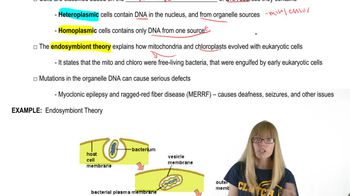- 1. Introduction to Genetics51m
- 2. Mendel's Laws of Inheritance3h 37m
- 3. Extensions to Mendelian Inheritance2h 41m
- 4. Genetic Mapping and Linkage2h 28m
- 5. Genetics of Bacteria and Viruses1h 21m
- 6. Chromosomal Variation1h 48m
- 7. DNA and Chromosome Structure56m
- 8. DNA Replication1h 10m
- 9. Mitosis and Meiosis1h 34m
- 10. Transcription1h 0m
- 11. Translation58m
- 12. Gene Regulation in Prokaryotes1h 19m
- 13. Gene Regulation in Eukaryotes44m
- 14. Genetic Control of Development44m
- 15. Genomes and Genomics1h 50m
- 16. Transposable Elements47m
- 17. Mutation, Repair, and Recombination1h 6m
- 18. Molecular Genetic Tools19m
- 19. Cancer Genetics29m
- 20. Quantitative Genetics1h 26m
- 21. Population Genetics50m
- 22. Evolutionary Genetics29m
As described in this chapter, mothers will pass on a mitochondrial defect to their offspring. In a type of gene therapy, one approach to circumvent this problem is to have two different maternal contributions, with the nucleus of the female with the defective mitochondria being placed in an enucleated egg derived from a female with normal mitochondria. After fertilization, the resulting offspring would have three parental sources of DNA—with nuclear DNA derived from a mother and a father, and mitochondrial DNA derived from another 'mother.' Recently, children with this genetic makeup have been born, but the elimination of defective mitochondria is not complete, with the amount of defective mitochondria derived from the defective mother ranging from 0 to 9%. Discuss potential complications resulting from such a mixture of genomes.
 Verified Solution
Verified Solution

